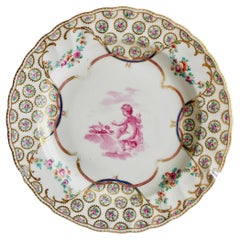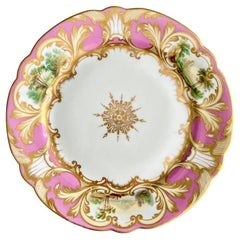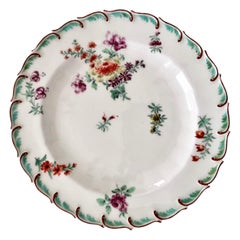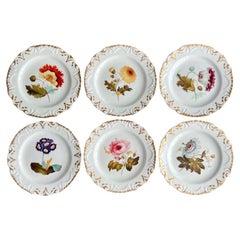Want more images or videos?
Request additional images or videos from the seller
1 of 15
Derby Sampson Hancock Plate, Gilt, Flowers, Signed by S Hancock, 1863-1895
$835List Price
About the Item
- Creator:Derby King Street (Maker)
- Dimensions:Height: 0.75 in (1.91 cm)Diameter: 8.5 in (21.59 cm)
- Style:Victorian (Of the Period)
- Materials and Techniques:
- Place of Origin:
- Period:
- Date of Manufacture:1863-1895
- Condition:Wear consistent with age and use. In excellent antique condition without any damage, repairs, crazing or significant wear; some very light rubbing.
- Seller Location:London, GB
- Reference Number:Seller: LT-DER031stDibs: LU4805126273092
About the Seller
5.0
Vetted Professional Seller
Every seller passes strict standards for authenticity and reliability
Established in 2016
1stDibs seller since 2019
227 sales on 1stDibs
Typical response time: 1 hour
Authenticity Guarantee
In the unlikely event there’s an issue with an item’s authenticity, contact us within 1 year for a full refund. DetailsMoney-Back Guarantee
If your item is not as described, is damaged in transit, or does not arrive, contact us within 7 days for a full refund. Details24-Hour Cancellation
You have a 24-hour grace period in which to reconsider your purchase, with no questions asked.Vetted Professional Sellers
Our world-class sellers must adhere to strict standards for service and quality, maintaining the integrity of our listings.Price-Match Guarantee
If you find that a seller listed the same item for a lower price elsewhere, we’ll match it.Trusted Global Delivery
Our best-in-class carrier network provides specialized shipping options worldwide, including custom delivery.You May Also Like
Pair Blue and Yellow Gilt Derby Soup Plates
By Royal Crown Derby Porcelain
Located in New York, NY
Pair blue and yellow gilt Derby soup plates. Pair hand-painted and gilt soups with alternating yellow and white striped gilt banded border with blue floral ...
Category
Antique Late 18th Century English Dinner Plates
Materials
Porcelain
Antique Topographical Derby English Porcelain Plate Entitled 'Near Derby'
By Derby
Located in Philadelphia, PA
A fine antique 19th century Derby hard paste porcelain plate.
Decorated with a hand painted topographical scene to its center.
The scene depicts a bucolic landscape 'Near Derby' in a gilt cartouche and surrounded by a gilt cornucopia...
Category
Antique 19th Century British George III Dinner Plates
Materials
Porcelain
$895
H 1.25 in W 8.78 in D 9.13 in
Antique Derby Porcelain Salmon Ground Plate, An Annual Lavetera, by John Brewer
By Derby
Located in Downingtown, PA
Antique Derby Porcelain Botanical Salmon-ground Plate,
Annual Lavetera,
by John Brewer,
Circa 1815.
The Derby porcelain plate is boldly p...
Category
Antique Early 19th Century English Georgian Dinner Plates
Materials
Porcelain
$750
H 0.75 in Dm 8.88 in
Derby Porcelain Plates, Pattern 126, Painted by William Longden, Set of Six
By Derby
Located in Downingtown, PA
Derby Porcelain Set of Six Fruit-Decorated Plates, Pattern 126,
Circa 1790
This exquisite set of six Derby porcelain plates, dating to circa 1790, is a testament to the refined art...
Category
Antique 1790s English Georgian Dinner Plates
Materials
Porcelain
$1,875 Sale Price / set
25% Off
H 1 in Dm 8.5 in
12 Royal Crown Derby Cobalt Blue Neoclassical Dessert Plates
By Royal Crown Derby Porcelain
Located in Great Barrington, MA
An unusual set of 12 Royal Crown Derby dessert plates featuring an elegant and restrained central subject of subtly different urns wit...
Category
Early 20th Century British Neoclassical Dinner Plates
Materials
Porcelain, Paste
Derby Porcelain Salmon Ground Plate, Marsh Hibiscus, after William Curtis
By Derby
Located in Downingtown, PA
Antique Derby Porcelain Botanical Salmon-ground Plate,
Marsh Hibiscus,
by John Brewer after Curtis, The Botanical Magazine, #882, 1806,
circa 1815.
The Derby Porcelain plate is superbly painted with a Marsh Hibiscus botanical specimen with richly gilded borders with swans and stylized flowerheads on a rich salmon ground.y gilded borders with swans and stylized flowerheads are on a rich salmon ground.
The flower is named on the reverse: "Marsh Hibiscus".
Diameter: 8 7/8 inches (22.5 cm)
Mark: crown, crossed batons, and D mark in red, numerals 4 & 13 in yellow & green inside foot rim.
John Brewer, (1764-1816)
John was the elder of two brothers who both worked at Derby. Their parents were both artists and from 1762-1767 had studios in London at Rupert Street. Brewer started working at Derby in 1795. He was a talented watercolorist and had never applied his art to porcelain painting. At Derby, he painted a variety of subject matters including plant and flower painting.
The Botanical Magazine is one of the oldest - and longest-published - of the British botanical...
Category
Antique Early 19th Century English Georgian Dinner Plates
Materials
Porcelain
Twelve Parcel Gilt Bohemian Porcelain Dinner Plates by P.A.L.T
Located in London, GB
Twelve parcel gilt Bohemian porcelain dinner plates by P.A.L.T
Czech, early 20th century
Measures: Height 2.5cm, diameter 27cm
This rare set of...
Category
Early 20th Century Czech Dinner Plates
Materials
Porcelain
12 Royal Crown Derby Service Plates with Two-Color Raised Paste Gold
By Royal Crown Derby Porcelain
Located in Great Barrington, MA
This magnificent set of 12, 19th century Royal Crown Derby service, presentation plates are fit for royalty with the subtle contrast of ivory...
Category
Antique 19th Century English Porcelain
Materials
Gold
12 Royal Crown Derby Neoclassical Dinner Plates with Profuse Raised Paste Gold
By Royal Crown Derby Porcelain
Located in Great Barrington, MA
There is great and then there is magnificent and these plates made by Royal Crown Derby qualify as magnificent! This set of 12 dinner plates exhibit all of the characteristics of the...
Category
Antique Early 1900s English Neoclassical Dinner Plates
Materials
Gold
$8,400 / set
H 1 in Dm 10 in
Set of 12 Royal Crown Derby Hand-Painted Dinner Plates with Floral Bouquets
By Royal Crown Derby Porcelain
Located in Great Barrington, MA
This set is a great example of the iconic artistry and style of Royal Crown Derby.
These plates are embellished with swags of vibrant hand-painted roses and two bands of acid etched...
Category
Antique Early 1900s English Dinner Plates
Materials
Porcelain
$4,200 / set
H 1 in Dm 10.25 in
More From This Seller
View AllCrown Derby Porcelain Plate, Puce Cherubs by Richard Askew, Georgian ca 1785
By Crown Derby
Located in London, GB
This is a beautiful Crown Derby plate made in about 1785. The very charming decoration of a puce putto is by Richard Askew.
The Derby Porcelain factory has its roots in the late 174...
Category
Antique 1780s English Georgian Dinner Plates
Materials
Porcelain
Samuel Alcock Plate, Pink and Gilt, Landscape Reserves, ca 1855
By Samuel Alcock & Co.
Located in London, GB
This is a beautiful plate in the 8-lobed shape, with a deep pink ground and rich pale yellow and gilt acanthus and shell decoration, three scrolled reserves with exceptionally finely...
Category
Antique 1850s English Rococo Revival Porcelain
Materials
Porcelain
Chelsea Plate, Feather Moulded with Flowers, Red Anchor Mark, ca 1755
By Chelsea Porcelain
Located in London, GB
This is a beautiful plate made by Chelsea in circa 1755, which is known as the "Red Anchor" period of the factory.
Chelsea was one of the very early adopters of porcelain in the British china industry. Founded in 1744 the Chelsea pottery was for about 40 years the leading maker of fine chinaware, excelling in their sense of style, perfection and constant innovation and inspiring many following generations of china makers.
The company was started by French silversmith Nicholas Sprimont and you can see the influence of the French style of silverware...
Category
Antique 1750s English George II Dinner Plates
Materials
Porcelain
Machin Set of 6 Plates, Moustache Shape, White with Flowers, ca 1825
By Machin
Located in London, GB
This is a beautiful set of 6 dessert plates made by Machin around 1825, which is known as the Regency period. The items have the famous "moustache" moulding picked out in gilt, a sim...
Category
Antique 1820s English Regency Dinner Plates
Materials
Porcelain
Coalport Saucer Dish Plate, Cobalt Blue, Gilt and Birds, Regency ca 1815
By Coalport Porcelain
Located in London, GB
This is a beautiful saucer dish or deep plate made by Coalport around the year 1815. This plate would have belonged to a large tea service. The plate is decorated with a deep cobalt ...
Category
Antique 1810s English Regency Porcelain
Materials
Porcelain
Yates Plate, White, Gilt Shark Teeth Pattern and Floral Reserves, ca 1825
By William Yates
Located in London, GB
This is beautiful plate made by the Yates factory in about 1825. The plate is decorated with in a white ground with finely hand painted flower reserves, gilt sprigs and a characteris...
Category
Antique 1820s English Regency Porcelain
Materials
Porcelain
Recently Viewed
View AllMore Ways To Browse
Antique Street Signs
1895 Porcelain
1895 Antiques
Royal Crown Derby Dinner Service
Porcelain Street Sign
Stevenson And Hancock
Gold Dinner Service
Longchamp Plate
Vintage Green Glass Dinner Plates
Bread And Butter Plates
Hells Kitchen
Plates And Dinnerware
Antique Shell Sign
Antique Transferware Plates
Apple Plate
Copeland Plates Antique
Daisy Plates
Lalique Plates



